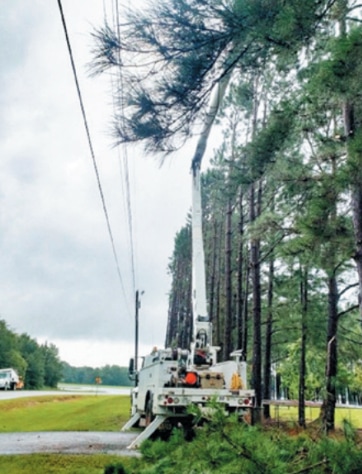 The first time many people encounter the term “right-of-way” is in a driver’s manual or on a driver’s license test. It brings to mind something you have (or yield to) when you’re behind the wheel of a motor vehicle.
The first time many people encounter the term “right-of-way” is in a driver’s manual or on a driver’s license test. It brings to mind something you have (or yield to) when you’re behind the wheel of a motor vehicle.
But in the electric co-op world, “right-of-way” (ROW) takes on an important alternate meaning. It refers to the corridor or path an electric line follows, either along a road or through the woods.
Trees and branches that are downed by storms are a primary cause of power outages. Co-ops across Georgia have developed aggressive ROW maintenance programs, routinely trimming vegetation near power lines that could become a problem. Storms still may bring down branches or trees, but the trimmed-back vegetation is far enough from power lines that it is much less likely to fall across them.
“A good right-of-way program significantly reduces outages,” says Harry Reeves, Georgia EMC’s vice president of training, education, and safety. “It also makes troubleshooting a lot easier.”
Trees along a utility ROW increase the possibility of power outages and blinks. They can also delay power restoration after storms because fallen trees and debris must be cleared before crews can gain access to damaged poles or lines.
If a tree branch inadvertently touches a power line, it can become hazardous—even deadly. When a tree limb comes in contact with a power line, someone touching or climbing the tree could be shocked or even electrocuted. It can also produce a spark, which can start a fire, especially if the area is very dry.
Electric cooperatives obtain ROW easements for new construction, giving permission to cut and keep clear all trees within a set distance of primary power lines, secondary and service lines.
Some co-ops use their own employees to do ROW work, while others hire contract crews.
Proper reclearing consists of removing trees, mowing underbrush, controlling vegetation growth, and trimming limbs that extend into the ROW.
Many times trees that are outside of the allowed cutting area of the ROW are responsible for outages. The trees and/ or tree limbs are not within the ROW, but the trees are tall enough to strike the wires when they fall.
If you believe that a tree on your property poses a threat to a power line, call your electric cooperative. If it is determined that the tree is a danger and could strike the wires in falling, it could be removed at no cost to you.
In addition, when planting a tree in your yard, keep in mind the tree’s size at maturity. The larger the full-grown tree will be, the farther it needs to be from a power line.
Safety and reliability are priorities for electric cooperatives. Proper ROW maintenance promotes both.
